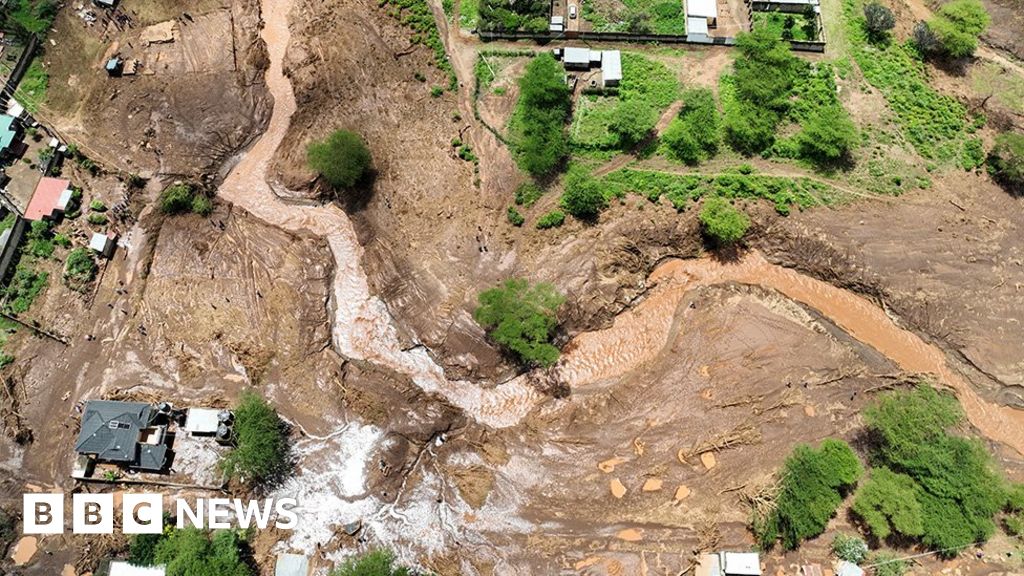
- Written by Barbara Plett Asher and Ian Wafula
- BBC News, Mai Maheu
About 50 people died in Kenya in a deluge that followed heavy rains and floods, a Red Cross official said.
People in villages near Mai Mahiu, about 60 kilometers (37 miles) from the capital, Nairobi, were swept away while they were sleeping.
Rescue efforts are continuing to pull people out of the mud, amid fears that the death toll will rise.
More than 100 people died in floods that devastated parts of Kenya last month.
A vast brown scar of mud, uprooted trees and smashed houses cuts through the Mai Mahiu area.
A rumbling sound woke people in the early hours of Monday as a wave of water crashed down from upriver.
Residents spoke of a night of frantic efforts to extract people from the raging flood and dig them out of the mud.
Deden Muiri, 60, said he heard the roaring sound and saw the flash of lightning. But before he had time to think, he was up to his neck in water.
He saw the flood taking his wife and sweeping him away in the opposite direction.
After Mwiri was convinced that he was going to die, he quietly said goodbye to his family.
Miraculously, he was able to grab a tree branch and cling to life by holding on to it.
He said that one of his daughters knows how to swim, and was able to save two of his grandchildren.
When we arrived, many people were out inspecting the damage, walking along the riverbank, searching through the wreckage, trying to come to terms with the disaster.
Peter Munning's house survived but the rest of his neighborhood did not.
“There are young children in the water, elderly people… people screaming, people crying, losing their lives and loved ones,” he said.
The Kenya Red Cross joined the search and rescue operations, with emergency response director Anthony Moshiri telling the BBC that the death toll had risen to 50.
“This is the worst I have ever encountered in my career,” he said, adding that not only were people's homes swept away, but their foundations were also swept away.
Police Chief Stephen Kirui said that among the bodies recovered so far were 17 children.
Local officials initially attributed the sudden wave of floodwaters to a nearby dam burst.
But Kenya's Ministry of Water, Sanitation and Irrigation said on Monday evening that the accident occurred as a result of a tunnel – which runs the Tongi River under a railway line – being blocked by “debris, stones, trees and soil” during the floods. Recent rains.
The ministry said in a statement that this prevented water from flowing through it downstream, which led to a pool of water suddenly washing over the railway line.
She added, “The area does not have a dam, and the only dam located upstream in a different tributary is the Mats Dam, which is in good condition and stable.”
The small villages of Kamuchiri and Kyangu were among the villages that bore the brunt of the disaster.
Peter Mohoho said most of his neighbors were swept away in Kyanugu, a village of about 18 houses.
Mohoho told the BBC: “I was sleeping when I heard a loud bang and screaming. The area was flooded. We started rescuing people.”
Pointing to the bag he was carrying, Mr Mohoho added: “This bag belongs to a child I know. He was washed away. I found it.” [the bag] downstream.”
The government has postponed the opening of schools across Kenya as more rain is expected, according to meteorological forecasts.
The floods caused the displacement of more than 130,000 people, and many took refuge in schools.
Heavy rains also fell in neighboring Tanzania and Burundi.
At least 155 people have been killed in Tanzania since January.
In Burundi, nearly 100,000 people were displaced.
The number of victims is unclear.
One of the biggest drivers of rainfall is the Indian Ocean Dipole (IOD).
The IOD – often called the “Indian El Niño” because of its similarity to its Pacific counterpart – refers to the difference in sea surface temperatures in opposite parts of the Indian Ocean.
During the positive phase, waters in the western Indian Ocean are warmer than normal and this can lead to heavy rainfall regardless of El Niño.
However, when both a positive IOD and El Niño occur at the same time, as was the case last year, rainfall in East Africa can become extreme.
One of the strongest positive IOD patterns on record coincided with one of the strongest El Niño patterns in 1997 and 1998, with severe flooding reported. These events caused the death of more than 6,000 people in five countries in the region.
Human-induced climate change also increases the likelihood of heavy rainfall because it leads to a rise in the temperature of the atmosphere.
More about floods in East Africa:

“Travel specialist. Typical social media scholar. Friend of animals everywhere. Freelance zombie ninja. Twitter buff.”





More Stories
Taiwan is preparing to face strong Typhoon Kung-ri
Israel orders residents of Baalbek, eastern Lebanon, to evacuate
Zelensky: North Korean forces are pushing the war with Russia “beyond the borders”